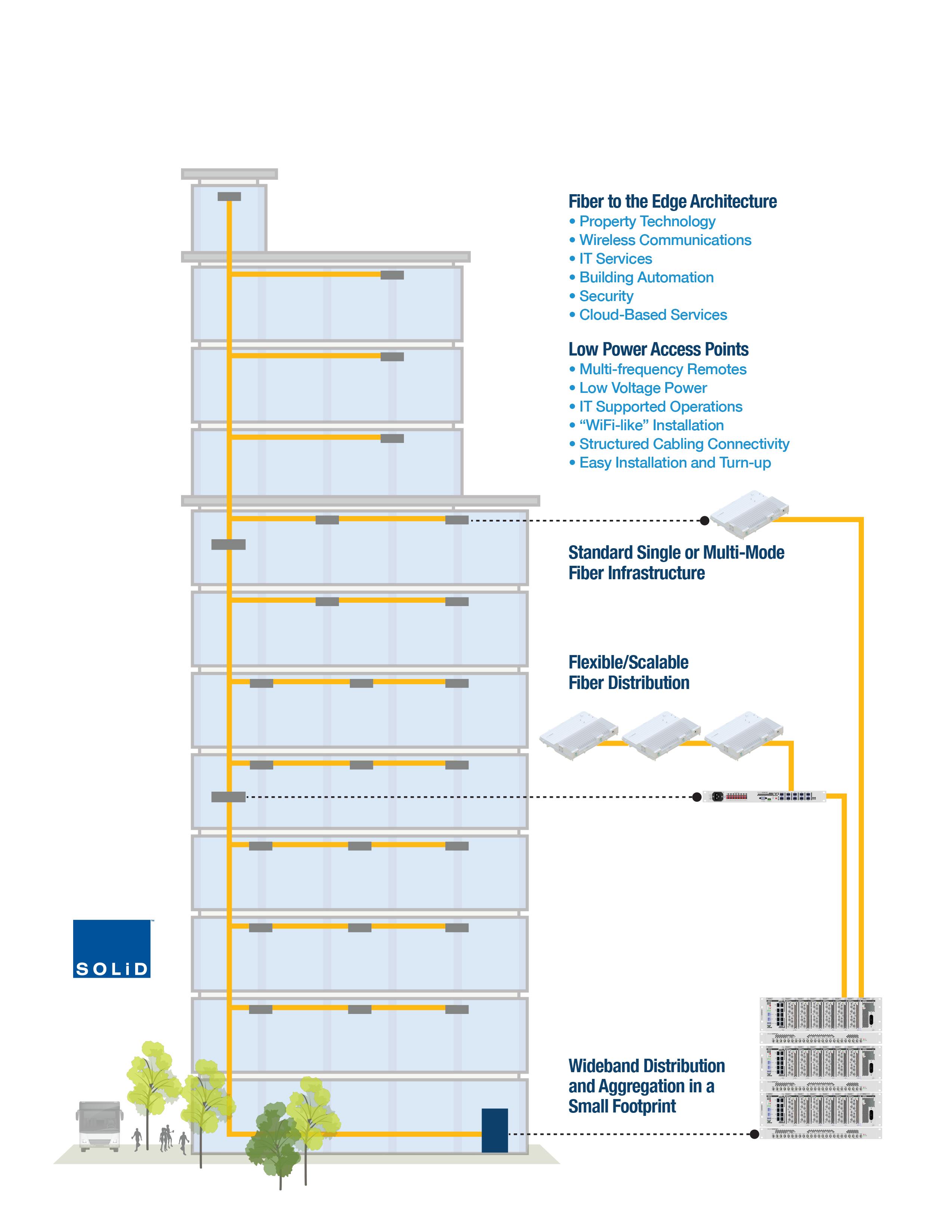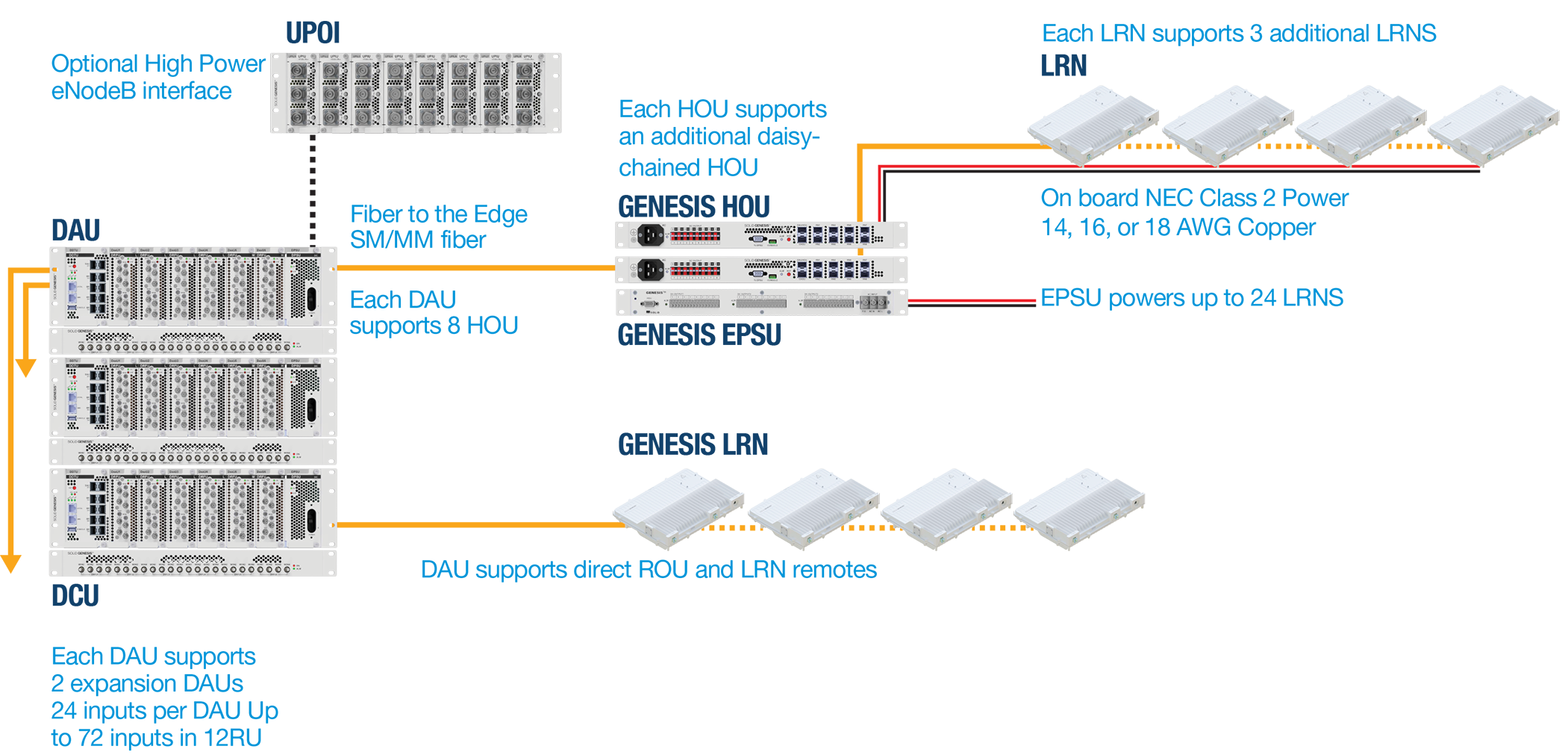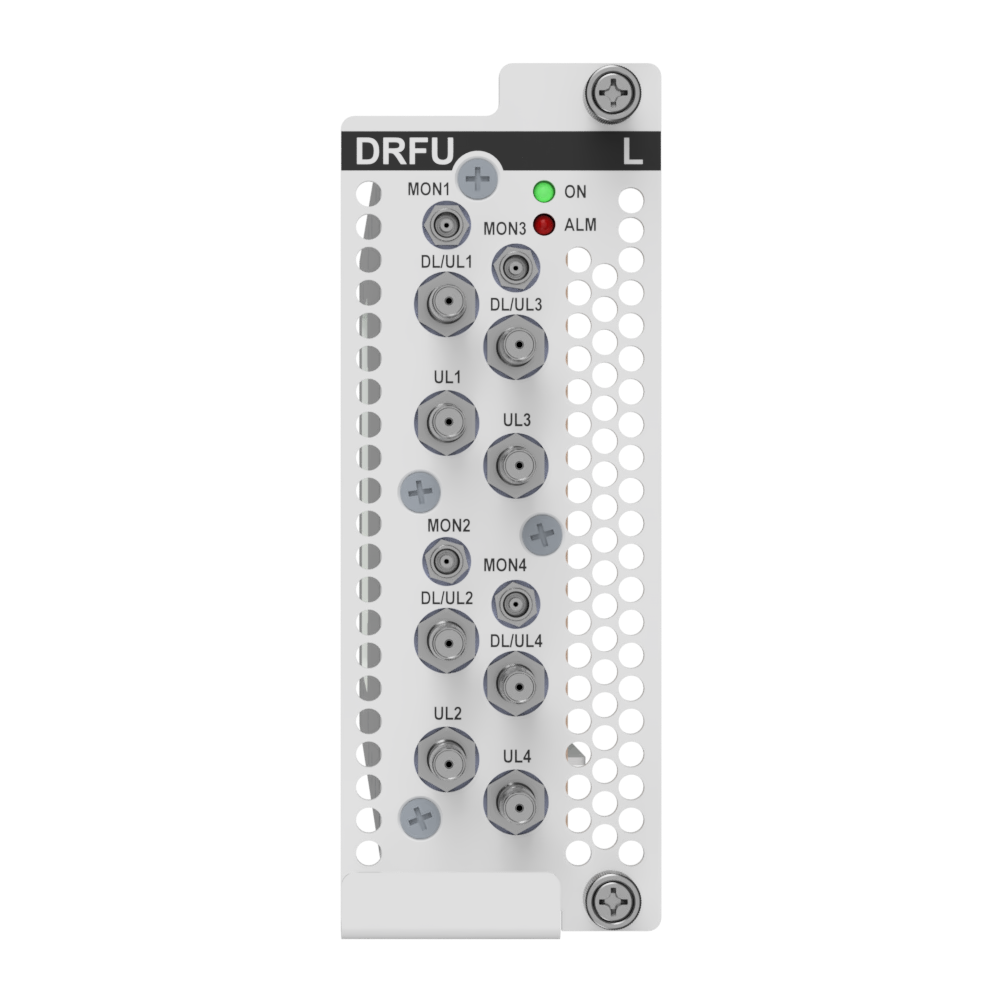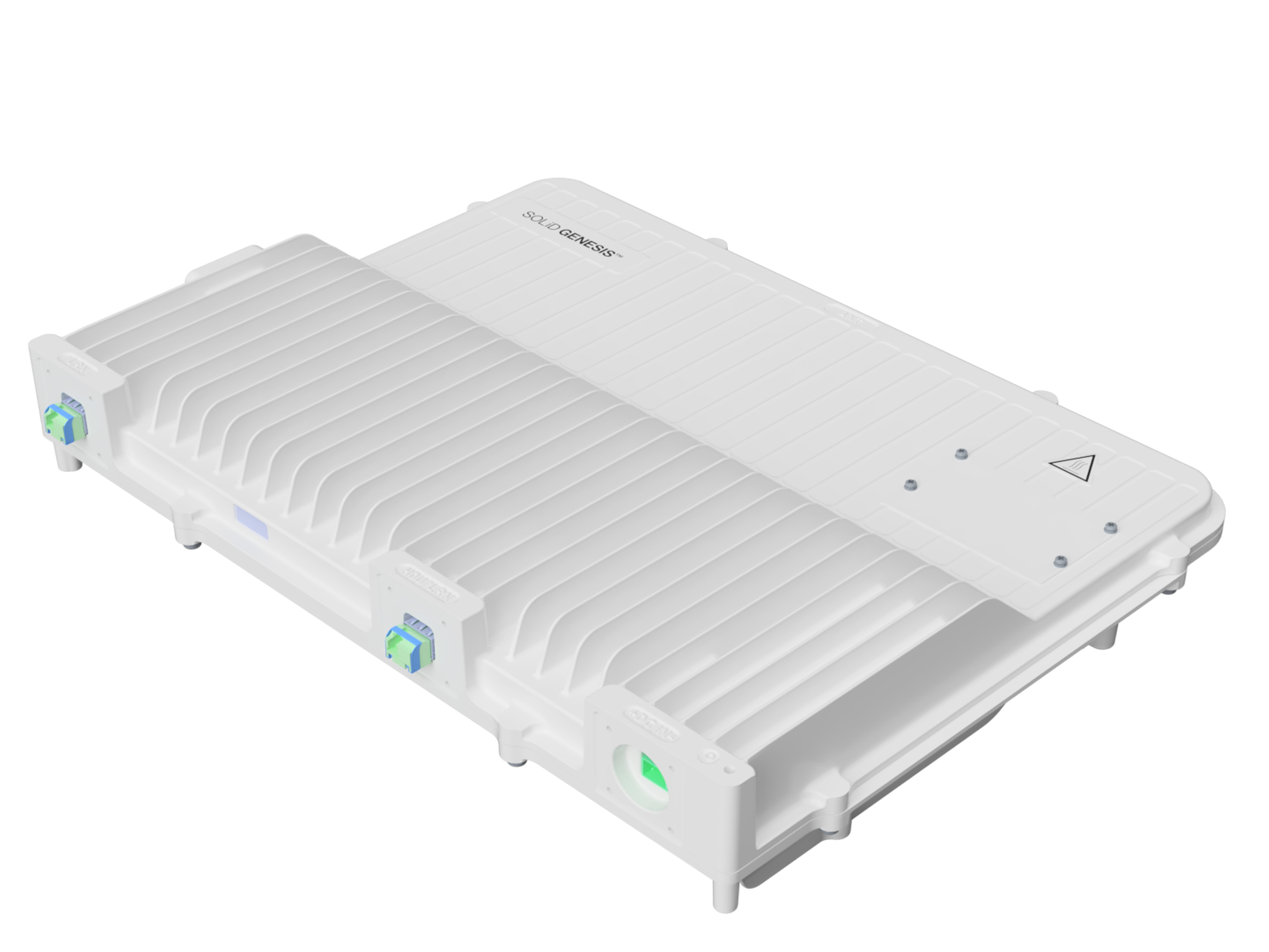Home › Products › GENESIS DAS
GENESIS DAS
SOLiD’s innovative Distributed Antenna Systems (DAS) and Professional Services are proven solutions to make buildings safer. We innovated our DAS solutions with public safety communications in mind.
Every day, millions of cellular users worldwide depend on their devices to keep them connected to work, family and friends. Unfortunately, for many, their connected experience ends once they enter a building. Our DAS solutions are deployed across all verticals, including entertainment (e.g., stadiums, arenas), mass transit, healthcare, education, retail, hospitality and enterprise.
While a Distributed Antenna System (DAS) is now a proven technology to deliver wireless coverage and capacity indoors, for many commercial buildings, the complexity and economics of traditional DAS mean it’s still not an option.
That’s why SOLiD designed GENESIS, a next generation DAS, that can be deployed on the building’s existing structured fiber infrastructure. GENESIS DAS is a simple, fiber-to-the-edge plug-in that can deliver private LTE wireless network connectivity for IoT and multi-operator commercial cellular service for the property’s staff, tenants and visitors.

Fiber-to-the-Edge Architecture
SOLiD’s GENESIS DAS uses standards-based structured cabling for communications and power distribution. Fiber optic and low voltage copper infrastructure delivers both superior performance and a significant economic advantage over traditional ½ inch coax cable.
This means our fiber-to-the-edge architecture makes efficient use of your infrastructure investment by leveraging your buildings existing fiber plant. GENESIS DAS is both scalable and flexible to meet the requirements of any building or venue.
Less Power More Options.
SOLiD has always led the industry with the broadest portfolio of remote amplifiers. The GENESIS solution continues the tradition by offering a low power (< 1W) remote node (LRN) that pushes the use of fiber optic infrastructure beyond the riser, beyond the closet, right to the edge.
Fiber connectivity to the LRN eliminates the challenges of deploying coax such as installer specialization, RF power distribution, testing and PIM. When you replace coax with fiber, you get better performance and easier, faster and more secure installation.
Fiber-to-the-edge infrastructure and the GENESIS LRN blurs traditional DAS thinking. Installation and management of the wireless network are enterprise scoped and more “WiFi-like” than DAS. But this doesn’t mean giving up the power of a traditional DAS. The GENESIS LRN supports up to six frequency bands simultaneously and can be installed practically anywhere to meet the demands of tenants and building improvements.
With powerful software tools and robust SOLiD engineering and construction, the GENESIS DAS is a perfect addition to your building’s PropTech strategy.
GENESIS Universal Point of Interface
The UPOI is an optional, passive signal attenuator providing up to 20dB of attenuation. The UPOI is used when the incoming signal exceeds the input threshold of the Distribution & Aggregation Unit (DAU). It’s a cost effective, small footprint option that saves rack space and engineering effort.
Consider these important GENESIS UPOI features:
- Passive, low PIM attenuator
- Wideband module supports 600-3800 MHz
- Number of ports matches the number of ports in the DAU
GENESIS Distributed & Aggregation Unit
The DAU is the heart of the GENESIS headend. It interfaces with the signal source and distributes signals to the LRNs. Each DAU supports up to 512 LRNs across a maximum eight sectors.
Consider these important GENESIS DAU features:
- Interfaces with 1 to 24 signal source inputs using wideband modules
- Distributes signals to any combination of eight Hub Optical Units (HOUs) and/or LRNs supporting a maximum of 512 LRNs
- Supports two expansion DAUs, local or remote, for more signal inputs
- Offers commissioning and management through an embedded intuitive user interface with complete remote access and functionality
GENESIS Distribution RF Unit
The DRFU is the module level component of the DAU, providing a flexible signal source interface available in three frequency ranges.
Features:
- Interfaces with up to four signal sources, simplex or duplex inputs
- Each input port is independent from other ports
- Input ports support any combination of bands within the range of the DRFU
- Three wideband modules (low, mid, high) to support bands from 600 – 2700 MHz
GENESIS Hub Optical Unit
The HOU distributes signals to the LRN via fiber optic cable. Each HOU supports up to eight LRNs. The HOU also provides low voltage power to the LRN. The HOU can support two additional HOUs for a total of three HOUs per DAU branch.
Consider these important GENESIS HOU features:
- Provides signals and power to eight LRNs
- Daisy chain up to two HOUs per branch
- Power to each remote is controlled and monitored
- Meets NEC Class 2
GENESIS Decode Unit
Each DAU is paired with a DCU, which provides the installer and system administrator with soft tools to decode signals, monitor performance and commission the network. The DCU can be accessed remotely for greater flexibility.
Consider these important GENESIS DCU features:
- Decodes channel and system information such as wireless operator, Sector ID, and reference power
- Supports remote commissioning using decoded information
GENESIS Expansion Power Supply Unit
The HOU supports eight fiber and power connections to drive up to eight LRNs. When LRNs are daisy chained, an EPSU is required to power these additional LRNs.
Consider these important GENESIS EPSU features:
- Provides power for up to 24 LRNs
- Rack mounted unit (1RU) that can hold up to three power supply modules each supporting up to eight LRNs
- Power to each remote is controlled and monitored
- Meets NEC Class 2
GENESIS Low-Power Remote Node
The LRN takes the fiber-to-the-edge working with your existing structured cabling infrastructure. Offering a compact form factor, enterprise friendly installation and low infrastructure impact, the LRN is key to providing private LTE and commercial cellular connectivity to the Middleprise and beyond.
Consider these important GENESIS LRN features:
- Supports six frequency bands 600 – 3800 MHz
- Flexible architecture ensures support for future frequencies
- Compatible with multimode or single mode optical fiber
- External antenna port(s) allows optimum antenna use
- SISO and MIMO options will be supported
- Daisy chain up to four remotes per branch
- Indoor or outdoor installation
- Easy above-ceiling or surface-mount installation
Want to learn more? Download the FREE brochure we’ve put together on SOLiD’s GENESIS DAS!








